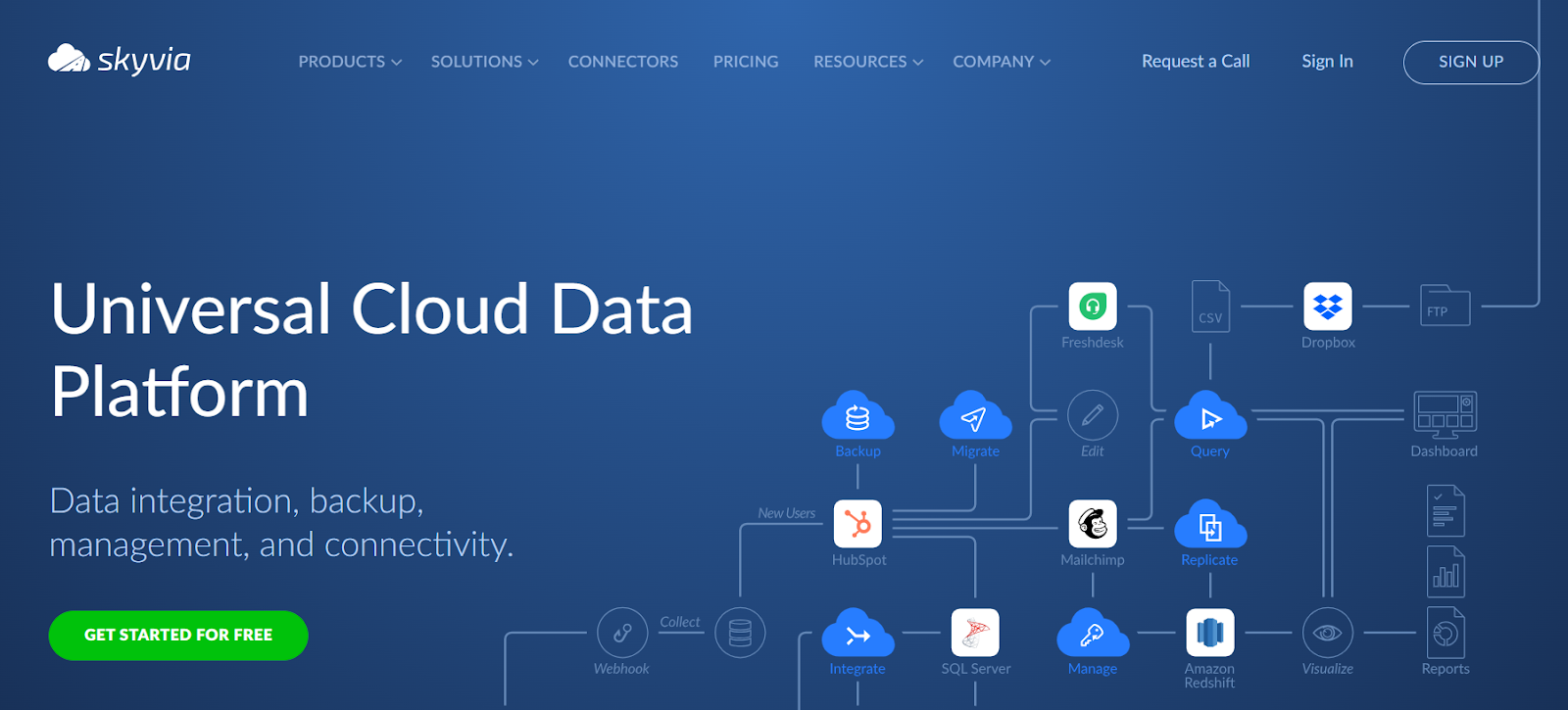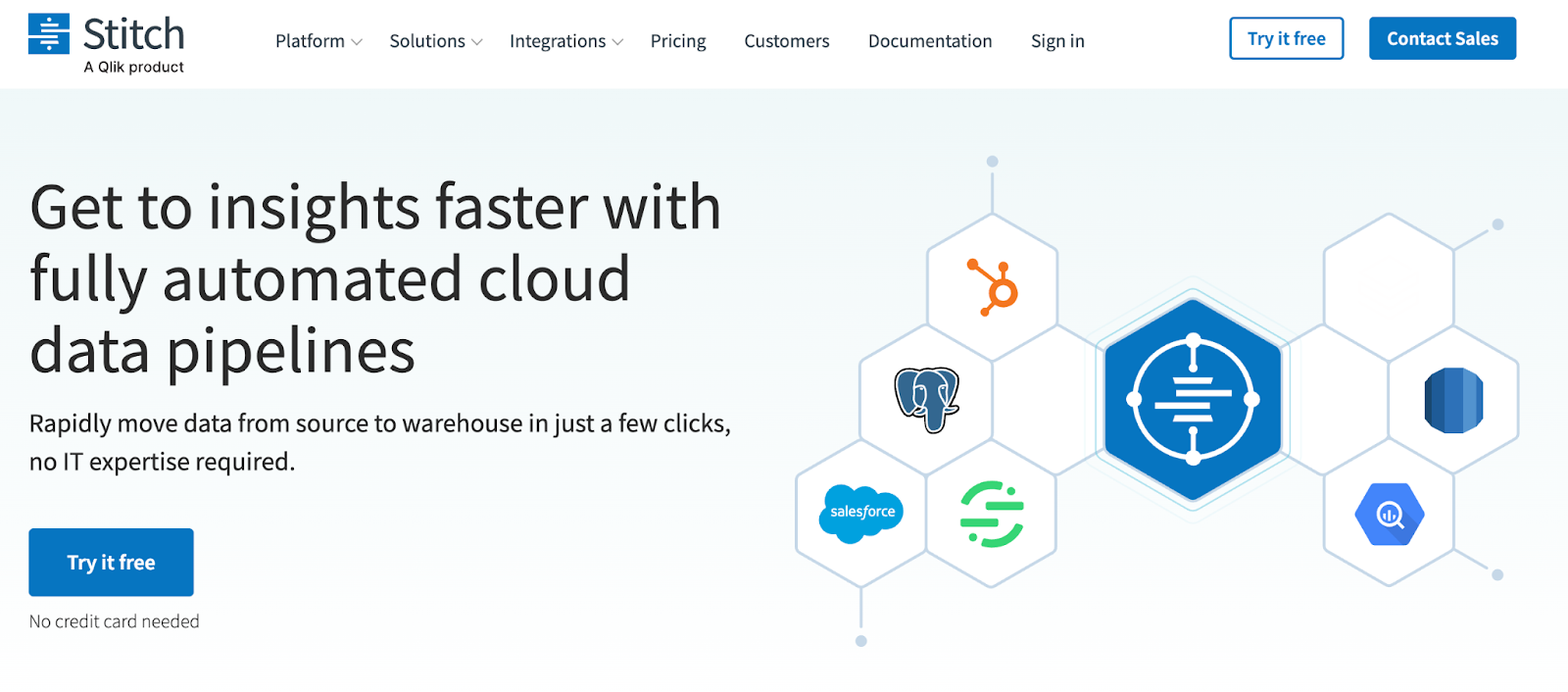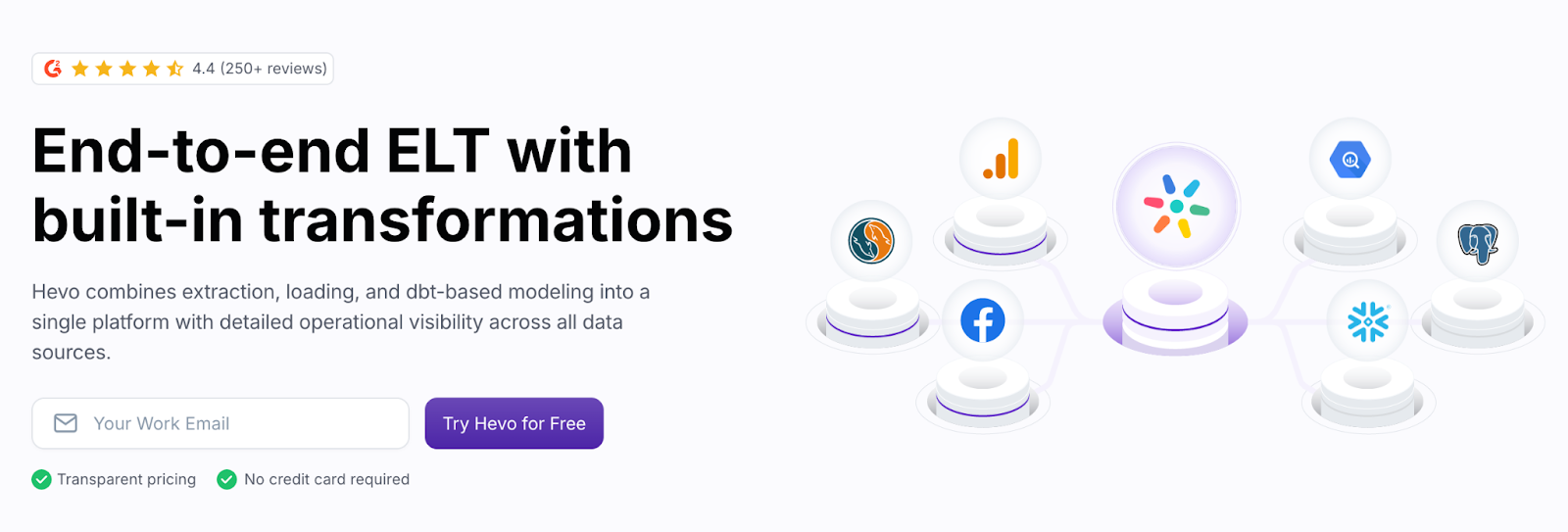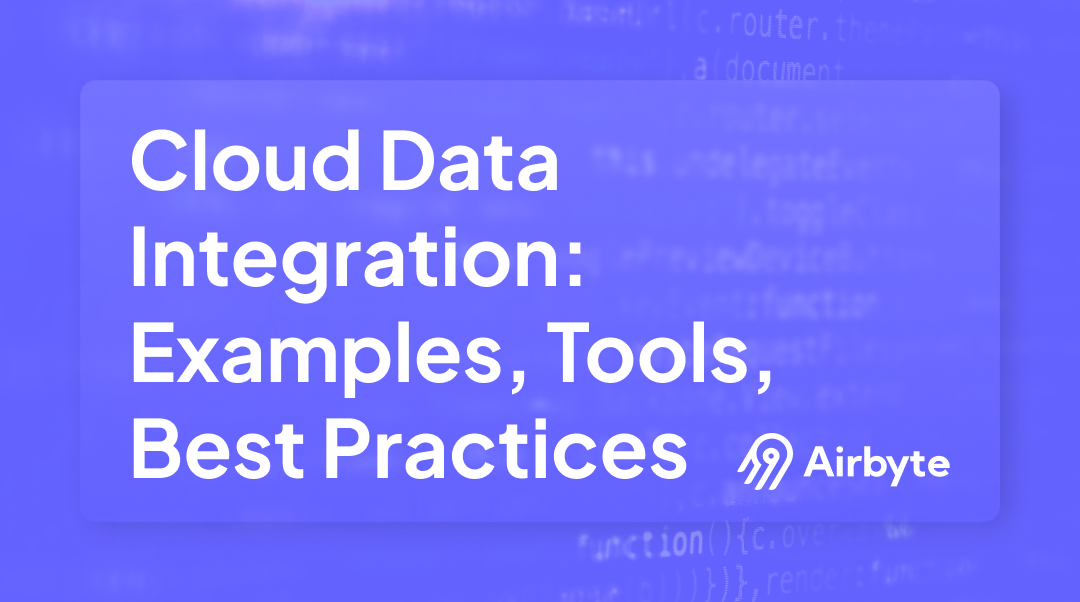What Is Cloud Data Integration?: Top Tools & Best Practices in 2026
Summarize this article with:
✨ AI Generated Summary
Cloud data integration consolidates data from multiple sources into a unified cloud platform, enabling streamlined analysis, improved decision-making, and scalable business models. Key benefits include eliminating data silos, ensuring synchronization via Change Data Capture (CDC), enhancing data quality, and offering cost-effective, flexible solutions.
- Popular tools include Airbyte (open-source, 600+ connectors), Fivetran (secure, 500+ connectors), Talend Cloud (data quality focus), Informatica IICS (AI-powered), Skyvia (no-code), Stitch (developer-friendly), and Hevo Data (real-time ELT).
- Cloud data integration is widely applied in IT, healthcare, marketing, and finance for unified data views, improved workflows, and enhanced security.
- Successful integration involves identifying sources, choosing tools, cleaning data, creating workflows, testing, and ongoing monitoring.
As the volume of data expands and spreads across multiple locations, your organization needs to plan strategies to consolidate and organize this data. Cloud data integration is an effective solution for dealing with your modern integration needs.
It empowers you to gather data from numerous locations into a unified platform, thereby fostering a streamlined data analysis and workflow. You can unlock hidden insights in your data and formulate optimized solutions to build a scalable business model.
In this article, you will explore the concept of cloud data integration and its benefits, along with a few examples. Moreover, you will also learn about popular cloud-based platforms and best practices to follow.
What is Cloud Data Integration?
Cloud data integration is the process of combining data from multiple systems, such as public, private, and on-premise, into a single, cloud-based, cohesive data repository. It aims to provide an effective, secure, and easily accessible data storage solution.
Depending on your organization and its unique requirements, the steps involved in cloud-based data integration may differ. However, the integration process primarily entails batch processing, real-time event streaming, and ETL or ELT pipelines.
Best Cloud Data Integration Tools
1. Airbyte
Airbyte is a popular cloud-based data integration platform that employs a modern ELT approach to consolidate data. It allows you to extract data from diverse sources such as databases, flat files, or SaaS applications and load them into a data lake or warehouse.
With Airbyte, you can automate your data pipeline creation using its rich library of 600+ pre-built connectors. If you want to use a connector that is unavailable, you can build a custom one using CDK or request a new one by contacting their sales team.

Some of the benefits of using Airbyte are:
- Aibyte is equipped with data replication features such as Change Data Capture. This lets you track changes in your source file and replicate them in the target system to maintain data integrity.
- It recently launched its open-source Python library, PyAirbyte, to facilitate seamless data integration for Python users. PyAirbyte lets you effortlessly extract data from Airbyte-supported connectors within your existing Python workflows.
Being open-source in nature, Airbyte has a vibrant community of 25000+ members who manage its platform. You can collaborate with others to share useful insights, discuss integration practices, and resolve queries arising during data ingestion.
2. Fivetran
Developed in 2012, Fivetran is a widespread cloud data integration tool. It allows you to automate your data pipelines with features such as data movement, transformation, and governance.
To facilitate seamless integration, Fivetran offers an extensive library of 500 pre-built connectors, allowing you to collect data from disparate sources and centralize it in your destination system. Additionally, its Function connector feature empowers you to create custom connectors for unique data sources.

Some of the benefits of using Fivetran are:
- With Fivetran, you can choose from various deployment options, such as hybrid, self-hosted, or cloud-based, depending on your data integration needs.
- Fivetran employs various security measures such as automated column blocking and hashing, user permission, data encryption, and SSH tunnels. These features protect your data from external threats and ensure data confidentiality.
3. Skyvia
Skyvia is a cloud-based data integration platform that simplifies data integration through a no-code methodology. This allows you to quickly migrate data from one place to another.
Skyvia employs an ETL approach that helps you to extract data from various sources, such as cloud applications or databases. Its vast connector library facilitates streamlined data extraction, transformation, and loading.

Some of the benefits of using Skyvia are:
- With Skyvia, you can take advantage of data replication capabilities. It enables you to replicate data between various sources, such as cloud applications, databases, and files.
- Skyvia provides you the flexibility to request custom connectors on its platform if they are unavailable in its pre-built connectors list.
4. Talend Cloud
Talend Cloud is a comprehensive data integration solution that supports hybrid and multi-cloud environments for ETL and ELT processes. It provides a visual drag-and-drop interface to streamline the creation of integration pipelines across cloud applications, databases, and on-premise systems.
Talend supports real-time and batch processing and includes a robust set of features for data quality, cleansing, and governance. It also includes built-in machine learning capabilities for data profiling and deduplication.

Some of the benefits of using Talend Cloud are:
- It includes a wide range of connectors for cloud apps, databases, and enterprise systems.
- Built-in features for data quality, profiling, and governance help ensure clean and trustworthy data.
- The drag-and-drop UI simplifies complex integration workflows, even for non-technical users.
5. Informatica IICS
Informatica Intelligent Cloud Services (IICS) is a powerful enterprise-grade data integration platform designed to handle large-scale, complex data workflows. It supports various integration methods like ETL, ELT, API-led, and application integration.
The platform uses the AI-powered CLAIRE engine for automating metadata discovery, data mapping, and anomaly detection. Informatica also supports real-time streaming and event-driven architectures.

Some of the benefits of using Informatica IICS are:
- The CLAIRE engine automates data mapping, discovery, and error detection using AI/ML.
- Offers extensive monitoring, alerting, and scheduling capabilities for better pipeline observability.
- Supports complex integration styles such as ETL, ELT, real-time streaming, and API-led integration.
6. Stitch
Stitch is a lightweight, developer-centric ETL platform built for quick deployment of data pipelines into cloud warehouses. It allows you to extract data from over 130 sources including popular SaaS apps and databases. It focuses on simplicity and transparency, offering a RESTful API and extensive documentation for building custom integrations. Stitch also supports incremental replication to keep your datasets updated efficiently.

Some of the benefits of using Stitch are:
- Stitch’s usage-based pricing model is ideal for startups and growing teams.
- It supports over 130 sources and offers incremental replication to minimize data load.
- Features automatic retries, logging, and failure alerts to ensure pipeline reliability.
7. Hevo Data
Hevo is an end-to-end cloud data pipeline platform designed for real-time and automated ELT. It enables seamless integration from 150+ sources without writing a single line of code.
Hevo supports advanced transformation capabilities on the fly, and lets you monitor pipeline health, failures, and performance metrics through an intuitive dashboard.

Some of the benefits of using Hevo Data are:
- Hevo provides auto-schema mapping and transformation capabilities without the need for code.
- Real-time streaming pipelines ensure up-to-date data across your systems.
- The platform includes robust monitoring, alerting, and failure resolution tools.
What are the benefits of Cloud Data Integration?
There are several benefits of implementing the cloud data integration approach. Some of them are:
Eliminate Data Silos
As your business expands, data gets scattered across multiple locations, formats, and environments, creating data silos. This fragmented data leads to a common issue of data sprawling, which restricts your ability to gain a holistic view to perform data analytics.
You can overcome these issues using cloud data integration solutions by integrating data into a single source of truth, such as a cloud data warehouse or data lake.
Ensure Data Synchronization
The primary goal of cloud data integration is to organize, sync, and store data in a centralized system. One of the ways to achieve this is by using CDC functionality, which allows you to keep data in sync with the source systems, thereby ensuring data consistency. This gives you complete control over your data and use cases.
Enhance Data-Driven Decisions
Cloud data integration will help you achieve accurate and consistent data across all the systems. This can be achieved through transformation steps that include data cleaning, pre-processing, and enrichment. Having a clean and organized dataset allows you to perform meaningful analysis and draw actionable insights from it.
Scalability and Flexibility
As your data volume grows, you can leverage the scalability of cloud data platforms to adapt to changing business needs. This eliminates the concerns about infrastructure limitations and empowers you to adapt your data strategy accordingly.
Cost-Effective Solution
Having a clear idea of your resources and integration needs empowers you to plan your expenses effectively. With cloud data integration, you can avoid the hassle of installing and managing on-premise software and hardware as they are completely managed by the cloud providers. Moreover, you can save the IT resources involved in generating code to perform complex integrations.
How to Perform Cloud Data Integration?
Performing cloud data integration involves several steps to ensure a smooth and efficient process. Here are a few of them to help you get started:
1. Identify Data Sources
Determine the data sources you want to integrate into your cloud-based system. These can include databases, applications, APIs, files, or even streaming data.
2. Choose an Integration Solution
Select a cloud-based data integration platform that aligns with your requirements. Consider factors such as data volume, complexity, processing capabilities, security, and cost.
3. Ensure Data Cleanliness
Clean and validate your data to eliminate duplicate entries and errors that can undermine the accuracy and reliability of your integrated data.
4. Implement Integration Workflows
Create integration workflows that define how data will flow from source systems to the cloud. This involves mapping your source data structures to the target cloud-based system, performing data transformations, and applying any necessary business rules or validations.
5. Test and Validate
Thoroughly test the data integration workflows to ensure that the integrated data is accurate, complete, and consistent. Use data validation testing tools to verify that your data meets the defined quality standards.
6. Monitor and Maintain the Integration
Continuously monitor the integration process to identify and resolve any issues that may arise. Regularly update your integration workflows to adapt to changing data sources or your business requirements.
Examples of Cloud Data Integration
1. IT Sector
Cloud data integration significantly impacts the IT industry as it facilitates the seamless integration of data and applications among all teams and departments within a business. This ensures a unified data landscape and eliminates data duplication.
Additionally, IT departments gain complete control over data pipelines, enabling them to implement robust data governance and security practices. Cloud data integration also simplifies IT management by allowing the migration of cloud or on-premise data to cloud warehouses and lakes for efficient storage.
2. Healthcare Services
Healthcare providers utilize cloud data integration to aggregate and analyze data from various sources, including Electronic Health Record (EHR) systems, billing systems, and medical devices. By centralizing and integrating this data in the cloud, doctors can gain a holistic view.
This allows them to identify patterns in patient medical records, expedite clinical treatment, and provide better services. Additionally, cloud data integration also enables secure data exchange and interoperability across different healthcare providers, which leads to personalized treatment.
3. Marketing
Businesses can optimize their marketing workflows using cloud data integration. It gives the marketing team complete visibility of each customer. This 360-degree view allows them to run hyper-personalized and targeted campaigns that provide potential customers with a satisfying experience.
By integrating data from disparate sources, such as website behavior or purchase history, marketing teams can personalize email campaigns or ads with targeted product recommendations. This data-driven approach can lead to significant improvement in conversion rates.
Cloud data integration also enables the sales team to sync lead management across the organization's systems and automate lead capture at every touchpoint. This real-time access to customer data empowers marketers to make informed decisions for their enterprise.
4. Finance Industry
Financial institutions require a unified view of their data to make informed decisions, manage risk, and ensure legal compliance. Cloud data integration plays a vital role by enabling them to collect information from multiple sources, including market data feeds, customer databases, transactional systems, and regulatory compliance systems.
This consolidated view empowers financial institutions to improve risk management, strengthen customer segmentation, and control fraud detection.
Final Thoughts
To sum up, cloud data integration plays a vital role in streamlining the integration procedures for your organization. It offers an effortless solution to consolidate your data, eliminate data silos, and establish a single source of truth.
By unifying your data in one place, cloud data integration allows you to derive meaningful conclusions from your dataset. This process can be leveraged using suitable cloud data integration tools listed above.
For a reliable and seamless data integration experience, we recommend using Airbyte, a powerful cloud-based data movement platform. Sign in today and explore its diverse features.
Frequently Asked Questions
Why is integration required in the cloud?
Cloud integration allows you to quickly add new tools or scale the existing ones without interfering with the current ecosystem, thereby ensuring your systems evolve with specific needs.
What is data integration in the cloud?
Data integration is the process of consolidating data from multiple sources in the cloud environment to gain a unified view of your dataset. This, in turn, allows your business to perform seamless data analytics and visualization.
What are the different types of cloud integration?
There are three types of cloud-based integration— cloud-to-cloud integration, cloud-to-on-premises integration, and a combination of both types.
What is a cloud data integration engineer?
A cloud integration engineer is someone who assists in migrating existing company networks and IT assets into the cloud. They help the enterprise enhance accessibility, backup, and connection by integrating the systems with cloud services.
Suggested Reads:

.webp)
